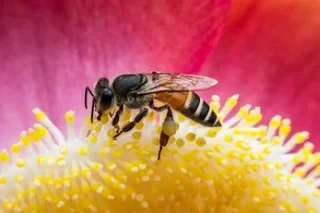There are over 20,000 kinds of bees on every continent except Antarctica, and they can be found everywhere there are flowers. Nearly 60,000 bees live in one bee colony, which is extremely organized and ordered. A single queen, a few hundred drones, and thousands of worker bees make up a bee colony.
The pheromones produced by the queen bee and dispersed to all the bees in the colony give each colony its own distinct character. Because bees are social insects, they can communicate with one another.
The buzzing sound of bees is produced by four small wings fluttering roughly 12,000 times per minute, propelling the bee to a speed of 15 miles per hour.
10 Animal Facts You Probably Didn't Know
The drone honey bee is the only type of male honey bee, and its primary job is to mate with the queen bee.
The huge body and large eyes separate it from other bees; the larger eyes are not a coincidence; larger eyes are necessary for the drone to have superior eyesight since mating occurs during flight, between 10 and 40 meters above the ground, and lasts 1 to 5 seconds.
The drones can recognize the queen thanks to her pheromone. The reproductive organs and abdominal tissue linked with the organs are pulled off after mating, and the drone dies soon after. A drone gets evicted from the colony and dies if it fails to mate before winter.
The queen bee is the biggest of all the bees. The queen bee lays 1500 eggs per day, for a total of approximately 1 million eggs throughout her lifetime.
The queen bee's body weight is 1500 eggs, therefore she lays more than her body weight every day. She is fed and groomed solely for the purpose of laying eggs by worker bees.
The queen bee strikes rival queen bees to eliminate competition, while worker bees sting to protect the hive from attack. Worker bees nurture young queen bees, who then struggle and sting each other until only one survives.
If the queen does not mate with a drone within 20 days of reaching maturity, she loses her ability to reproduce, and all eggs are left unfertilized, resulting in drones.
Worker bees are all female and have a lifespan of 42-45 days on average. A single worker bee will only make 1/12 teaspoon of honey throughout its lifespan. Though it may appear insignificant, a worker bee can visit up to 2000 flowers every day.
Aside from producing honey, worker bees construct and guard the hive, seal honey, maintain the hive by removing dead bees and larva, maintain the hive's temperature at 34.4 degrees Celsius, and cover the hive in propolis to prevent bacteria and germs. Aside from these responsibilities, worker bees feed the drones, queen bee, and young larvae.
Nurse bees, queen bee's attendants, construction workers, undertaker bees, and foragers are among the different types of worker bees. We've decided to share this fantastic infographic on 10 Amazing Bee Facts with you, and we hope you enjoy it.


